-
 Bitcoin
Bitcoin $105,128.3815
3.90% -
 Ethereum
Ethereum $2,416.0020
7.44% -
 Tether USDt
Tether USDt $1.0005
0.02% -
 XRP
XRP $2.1746
8.78% -
 BNB
BNB $639.2755
3.53% -
 Solana
Solana $144.4068
7.70% -
 USDC
USDC $1.0000
-0.01% -
 TRON
TRON $0.2729
1.26% -
 Dogecoin
Dogecoin $0.1628
6.63% -
 Cardano
Cardano $0.5826
7.56% -
 Hyperliquid
Hyperliquid $37.1757
6.20% -
 Sui
Sui $2.7783
11.64% -
 Bitcoin Cash
Bitcoin Cash $462.3940
2.42% -
 Chainlink
Chainlink $13.1350
11.22% -
 UNUS SED LEO
UNUS SED LEO $9.1304
0.83% -
 Stellar
Stellar $0.2476
8.34% -
 Avalanche
Avalanche $18.0617
6.94% -
 Toncoin
Toncoin $2.9043
3.64% -
 Shiba Inu
Shiba Inu $0.0...01161
7.29% -
 Hedera
Hedera $0.1515
11.26% -
 Litecoin
Litecoin $84.2187
3.78% -
 Monero
Monero $313.8446
4.70% -
 Ethena USDe
Ethena USDe $1.0006
0.03% -
 Polkadot
Polkadot $3.4344
6.81% -
 Dai
Dai $0.9999
0.00% -
 Bitget Token
Bitget Token $4.2647
5.88% -
 Uniswap
Uniswap $6.9164
11.66% -
 Pepe
Pepe $0.0...09897
10.79% -
 Pi
Pi $0.5326
6.57% -
 Aave
Aave $259.4000
13.30%
Will the high propeller fall? In what cases will it continue to rise?
A "high propeller" crypto may keep rising if backed by strong fundamentals, community support, and real-world adoption, but lacks of these could signal a sharp drop.
Jun 24, 2025 at 04:29 pm
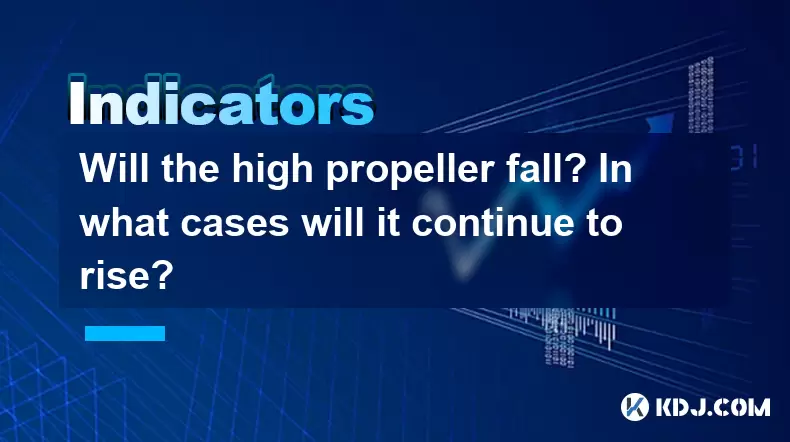
What Does "High Propeller" Mean in the Cryptocurrency Context?
In the cryptocurrency community, the term "high propeller" is often used colloquially to refer to a digital asset or token that has experienced a rapid and significant price surge. This expression typically describes coins or tokens that have seen their value rise sharply over a short period, sometimes without clear fundamental backing. The phrase suggests volatility and uncertainty — much like a spinning propeller high in the air, such assets are unstable and may either continue rising or fall dramatically.
When someone asks whether the "high propeller will fall," they're essentially questioning the sustainability of a cryptocurrency's steep upward trajectory. It’s a concern shared by many traders and investors who seek to understand whether a coin’s current valuation is justified or if it’s poised for a correction.
Signs That Indicate a Potential Drop in a High-Performing Cryptocurrency
A sudden price increase doesn't guarantee long-term growth. Several red flags can signal an imminent drop in a cryptocurrency that has been labeled as a "high propeller."
- Lack of Fundamental Value: If the project behind the coin lacks real-world utility, strong development activity, or a viable business model, its price rally may be speculative.
- Overhyped Marketing Campaigns: Projects with aggressive social media campaigns but little technical progress can attract short-term hype, leading to inflated prices followed by sharp declines.
- Low Trading Volume Despite Price Surge: A surge in price without a proportional increase in trading volume is often a warning sign. It may indicate artificial manipulation rather than genuine market demand.
- Negative News or Regulatory Scrutiny: Any unfavorable regulatory developments or bad press can trigger panic selling among holders, causing a rapid price drop.
These indicators should not be ignored when evaluating whether a "high propeller" cryptocurrency might soon decline.
Conditions Under Which a High-Performing Cryptocurrency May Continue Rising
Conversely, there are scenarios where a cryptocurrency experiencing a sharp rise may continue climbing instead of falling back down. These conditions generally revolve around solid fundamentals and positive market sentiment.
- Strong Community Engagement: Projects with active, supportive communities tend to sustain momentum. Strong engagement on platforms like Telegram, Discord, and Twitter can indicate ongoing interest.
- Positive Technological Developments: Regular updates, successful testnets, mainnet launches, or integrations with major platforms can boost investor confidence.
- Partnerships and Real-World Adoption: When a cryptocurrency forms strategic alliances or gets adopted by businesses or institutions, it often signals legitimacy and future potential.
- Market Timing and Broader Trends: Sometimes, even lesser-known projects benefit from favorable market conditions, such as bull runs or increased institutional interest in crypto.
If these factors align, a "high propeller" cryptocurrency may defy expectations and maintain or increase its upward trajectory.
How to Monitor On-Chain Metrics to Predict Movement
To determine whether a cryptocurrency classified as a "high propeller" will fall or rise further, investors often turn to on-chain analytics. These tools provide insights into network activity and holder behavior.
- Wallet Accumulation/Whale Movements: Monitoring large wallet movements can reveal whether big players are buying (accumulating) or selling (distributing).
- Exchange Inflows and Outflows: A sudden spike in exchange inflows may suggest profit-taking, while outflows could imply long-term holding or cold storage movement.
- Active Addresses and Transaction Count: An increasing number of daily active addresses and transactions indicates growing usage and adoption.
- Holders' Behavior: A decrease in short-term holders and an increase in long-term holders may signal confidence in the asset’s future.
Using platforms like Glassnode, Santiment, or Dune Analytics, traders can analyze these metrics to make more informed decisions about whether a "high propeller" coin is likely to fall or keep rising.
Technical Analysis Tools to Assess Future Price Direction
Technical analysis plays a crucial role in predicting whether a "high propeller" cryptocurrency will continue rising or experience a reversal. Traders use various tools and patterns to assess market psychology and trend strength.
- Relative Strength Index (RSI): RSI values above 70 typically indicate overbought conditions, which may precede a pullback. However, during strong uptrends, RSI can remain elevated for extended periods.
- Moving Averages: The position of price relative to key moving averages (like the 50-day or 200-day MA) helps determine trend direction. A golden cross (shorter MA crossing above longer MA) often signals bullish momentum.
- Volume Patterns: Sudden spikes in volume accompanied by price surges may confirm trend continuation, while declining volume during rallies may suggest weakening momentum.
- Support and Resistance Levels: Identifying key psychological or historical price levels can help anticipate breakouts or breakdowns. Strong resistance breaks often lead to continued upward movement.
Applying these technical tools allows traders to better assess whether a "high propeller" cryptocurrency is in a sustainable uptrend or at risk of a correction.
Frequently Asked Questions
Can a High Propeller Coin Recover After a Sharp Drop?
Yes, some cryptocurrencies that experience a sharp decline after a rapid rise can recover, especially if the underlying project continues to develop and gain adoption. Recovery depends on market sentiment, renewed investor confidence, and ongoing improvements within the project.
Is It Safe to Buy a High Propeller Coin During Its Uptrend?
Buying during an uptrend can be profitable, but it also carries risk. Investors should conduct thorough research, assess the project's fundamentals, and consider setting stop-loss orders to manage potential downside.
How Do I Differentiate Between a Pump-and-Dump Scheme and a Legitimate High Propeller Coin?
Legitimate high-performing coins usually have transparent teams, active development, and real-world applications. Pump-and-dump schemes often lack transparency, have minimal utility, and rely heavily on coordinated social media hype.
Are Altcoins More Likely to Become High Propellers Compared to Bitcoin or Ethereum?
Altcoins are more prone to becoming "high propellers" due to lower market capitalization and higher volatility. Bitcoin and Ethereum, being larger and more established, tend to move in more predictable patterns compared to smaller-cap altcoins.
Disclaimer:info@kdj.com
The information provided is not trading advice. kdj.com does not assume any responsibility for any investments made based on the information provided in this article. Cryptocurrencies are highly volatile and it is highly recommended that you invest with caution after thorough research!
If you believe that the content used on this website infringes your copyright, please contact us immediately (info@kdj.com) and we will delete it promptly.
- XRP Price Surge: Latest News and Analysis – Can XRP Reach New Heights?
- 2025-06-24 20:45:12
- Stablecoin Surge in South Korea: Kakao Pay's Venture and the Stock Rally
- 2025-06-24 20:25:13
- Unstaked Presale Heats Up as SHIB Evolves & Toncoin GameFi Takes Aim
- 2025-06-24 21:05:12
- DOT Miners, Middle East, and Investors: Navigating Uncertainty
- 2025-06-24 20:25:13
- Bitcoin Purchasing in 2025: A New Yorker's Guide to the Crypto Craze
- 2025-06-24 21:05:13
- Blockchain Stocks, Decentralized World, and Profit: Navigating the Future of Finance
- 2025-06-24 21:25:12
Related knowledge
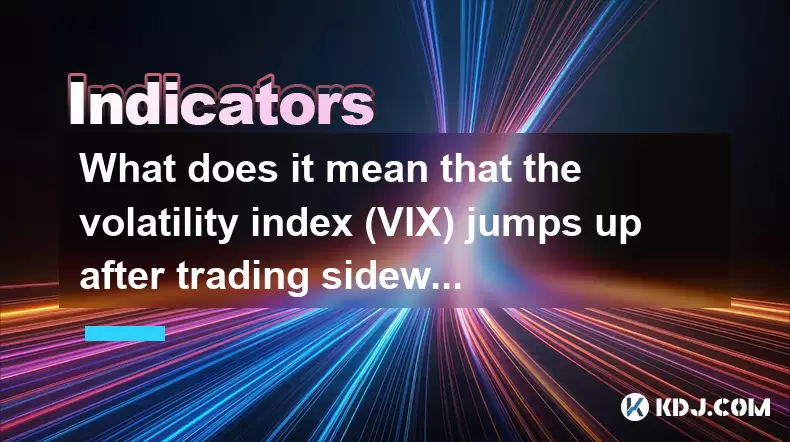
What does it mean that the volatility index (VIX) jumps up after trading sideways at a low level?
Jun 24,2025 at 09:35pm
Understanding the Volatility Index (VIX)The Volatility Index (VIX), often referred to as the 'fear gauge,' is a real-time market index that represents the market's expectation of 30-day forward-looking volatility. It is calculated by the Chicago Board Options Exchange (CBOE) based on the price inputs of S&P 500 index options. In the context of cryptocur...

What does it mean when the stochastic indicator repeatedly fluctuates at the 50 horizontal line?
Jun 24,2025 at 09:08pm
Understanding the Stochastic Indicator in Cryptocurrency TradingThe stochastic indicator is a popular momentum oscillator used by traders to identify potential trend reversals and overbought or oversold conditions. In cryptocurrency trading, where price movements can be highly volatile, understanding how this tool behaves becomes crucial for making info...
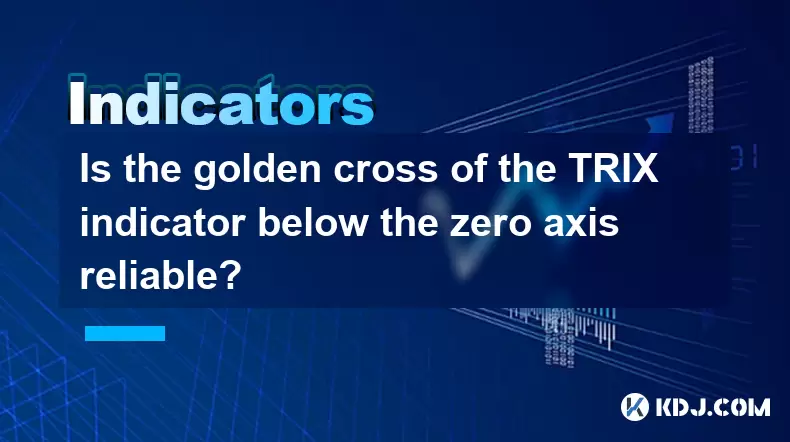
Is the golden cross of the TRIX indicator below the zero axis reliable?
Jun 24,2025 at 09:22pm
Understanding the TRIX Indicator and Its SignificanceThe TRIX (Triple Exponential Moving Average) indicator is a momentum oscillator used in technical analysis to identify oversold or overbought conditions, as well as potential trend reversals. It is calculated by smoothing price data three times using exponential moving averages and then taking the per...
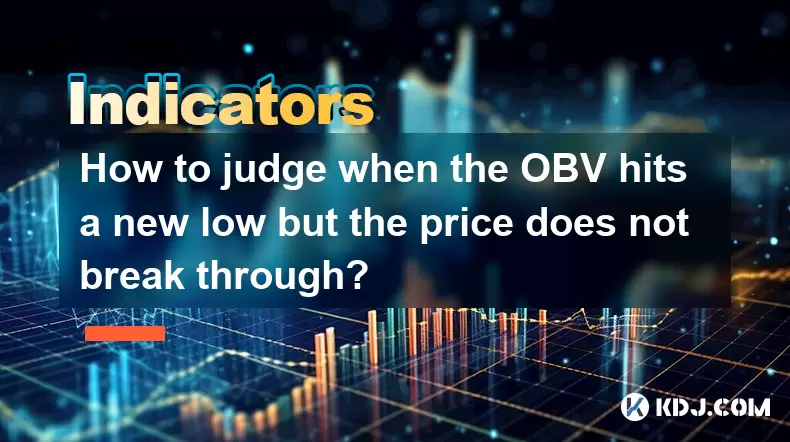
How to judge when the OBV hits a new low but the price does not break through?
Jun 24,2025 at 07:56pm
Understanding the Basics of OBV and Price ActionOn-Balance Volume (OBV) is a momentum indicator that uses volume flow to predict changes in stock or cryptocurrency prices. The core principle behind OBV is that volume often precedes price movement. When OBV hits a new low, but the price does not break through its previous support level, this can indicate...
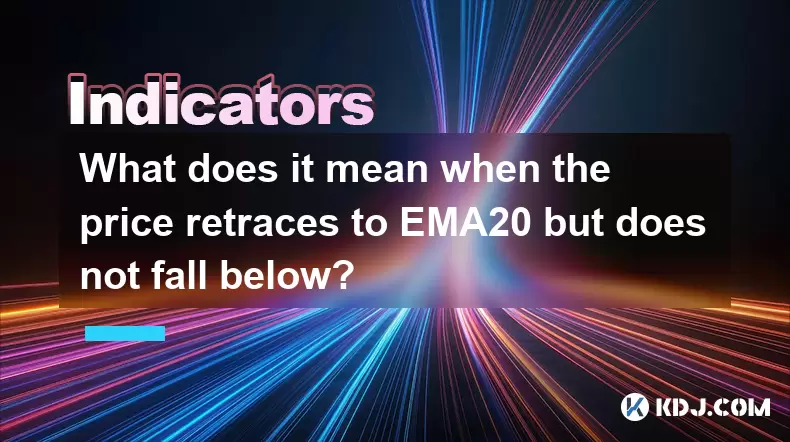
What does it mean when the price retraces to EMA20 but does not fall below?
Jun 24,2025 at 08:49pm
Understanding the EMA20 Indicator in Cryptocurrency TradingThe Exponential Moving Average (EMA) with a 20-period setting, commonly referred to as EMA20, is one of the most widely used technical indicators in cryptocurrency trading. It gives more weight to recent price data, making it more responsive to current price movements compared to simple moving a...
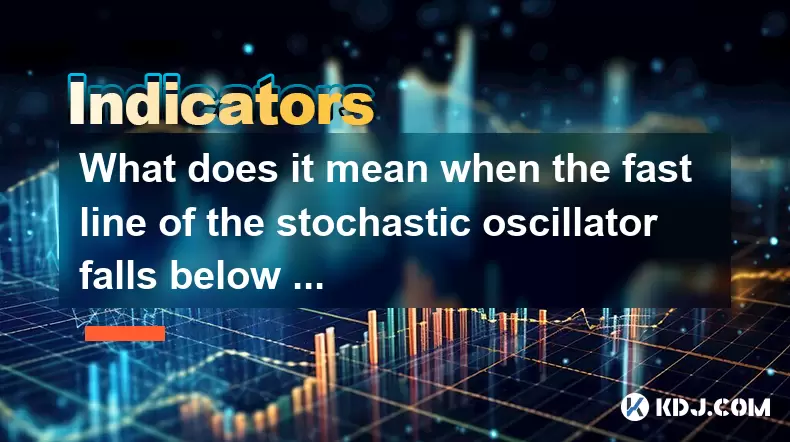
What does it mean when the fast line of the stochastic oscillator falls below the slow line?
Jun 24,2025 at 07:07pm
Understanding the Stochastic OscillatorThe stochastic oscillator is a momentum indicator used in technical analysis to assess overbought or oversold conditions in financial markets, including cryptocurrencies. It consists of two lines: the fast line (typically %K) and the slow line (typically %D). The fast line represents the current closing price relat...

What does it mean that the volatility index (VIX) jumps up after trading sideways at a low level?
Jun 24,2025 at 09:35pm
Understanding the Volatility Index (VIX)The Volatility Index (VIX), often referred to as the 'fear gauge,' is a real-time market index that represents the market's expectation of 30-day forward-looking volatility. It is calculated by the Chicago Board Options Exchange (CBOE) based on the price inputs of S&P 500 index options. In the context of cryptocur...

What does it mean when the stochastic indicator repeatedly fluctuates at the 50 horizontal line?
Jun 24,2025 at 09:08pm
Understanding the Stochastic Indicator in Cryptocurrency TradingThe stochastic indicator is a popular momentum oscillator used by traders to identify potential trend reversals and overbought or oversold conditions. In cryptocurrency trading, where price movements can be highly volatile, understanding how this tool behaves becomes crucial for making info...

Is the golden cross of the TRIX indicator below the zero axis reliable?
Jun 24,2025 at 09:22pm
Understanding the TRIX Indicator and Its SignificanceThe TRIX (Triple Exponential Moving Average) indicator is a momentum oscillator used in technical analysis to identify oversold or overbought conditions, as well as potential trend reversals. It is calculated by smoothing price data three times using exponential moving averages and then taking the per...

How to judge when the OBV hits a new low but the price does not break through?
Jun 24,2025 at 07:56pm
Understanding the Basics of OBV and Price ActionOn-Balance Volume (OBV) is a momentum indicator that uses volume flow to predict changes in stock or cryptocurrency prices. The core principle behind OBV is that volume often precedes price movement. When OBV hits a new low, but the price does not break through its previous support level, this can indicate...

What does it mean when the price retraces to EMA20 but does not fall below?
Jun 24,2025 at 08:49pm
Understanding the EMA20 Indicator in Cryptocurrency TradingThe Exponential Moving Average (EMA) with a 20-period setting, commonly referred to as EMA20, is one of the most widely used technical indicators in cryptocurrency trading. It gives more weight to recent price data, making it more responsive to current price movements compared to simple moving a...

What does it mean when the fast line of the stochastic oscillator falls below the slow line?
Jun 24,2025 at 07:07pm
Understanding the Stochastic OscillatorThe stochastic oscillator is a momentum indicator used in technical analysis to assess overbought or oversold conditions in financial markets, including cryptocurrencies. It consists of two lines: the fast line (typically %K) and the slow line (typically %D). The fast line represents the current closing price relat...
See all articles
























































































